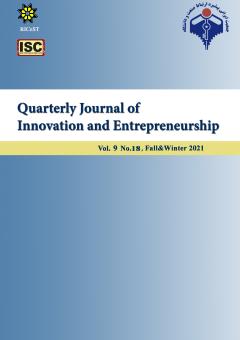Identification and Prioritization of performance evaluation indicators of knowledge-based companies
Subject Areas : عمومىBakhtiar Ostadi 1 * , Masoud Sadri 2
1 -
2 - Tarbiat Modares University
Keywords: Performance evaluation, Knowledge-based companies, Performance indicators stry,
Abstract :
The importance of knowledge-based companies in the economies of the countries and their role in GNP has increased in recent years, and many efforts have been made to develop a comprehensive and consistent indicators for evaluating these companies. The issue of performance evaluation of these companies is still new in Iran, and in the past, many studies have not been conducted on suitable examples of these companies. Therefore, the purpose of this research is to identify and categorize the most important and effective indicators in the performance of knowledge-based companies, in line with the industry conditions in Iran. Initial indicators are extracted from literature review, related documents and initial interviews with experts in this field. Then, final indicators are determined through designing and distributing questionnaires, structured interviews with experts and analyzing the results of received questionnaires. After validating the final indices, 22 indicators are verified and categorized into 5 groups, and finally, by computing the coefficients of variance (CV), the indexes are arranged from the most important to the least significant. Accordingly, the added value resulting from the technology used in the product, the level of education of the employees and the number of R & D staff are the most important, respectively. Due to the fact that these results are directly related to the experts in this field, it is expected that using the data of knowledgeable companies and implementation on one of the appropriate models of performance evaluation will result in meaningful result.
1.اقبال مجد مهدی، صفری علی، شانمی برزکی علی.۱۳۹۷. تأثیر کارآفرینی راهبردی بر عملکرد کسب و کار: نقش قابلیت پویای سازمان و آشفتگی محیط کسب و کار در شرکتهای دانشبنیان استان اصفهان. فصلنامه توسعه کارآفرینی. دوره۱۱. شماره۱. ص۱۹-۱.
2. امامقلیزاده سعید، فلاح صابر، رضوی حمیدرضا. ۱۳۸۹. نقش جدید دانشگاه¬ها: ایجاد و توسعه¬ی شرکت¬های کوچک و متوسط دانش¬بنیان. اولین همایش ملی دانشگاه کارآفرین (صنعت دانش¬محور), دانشگاه مازندران، مازندران، ایران، ص۱-۱۵.
3. امیری حمیدرضا، استادی بختیار، شیخمحمدی مجید.۱۳۹۲. ارائه چارچوب مفهومی ارزیابی عملکرد سازمانی چندسطحی مبتنی بر مدلهای رایج ارزیابی عملکرد. دهمین کنفرانس بینالمللی مهندسی صنایع.دانشگاه تهران.تهران.ص۷-۱.
4. باباخانیان مهدی، ۱۳۹۳. شناسایی عوامل زمینه¬ای مؤثر بر راهاندازی شرکتهای زایشی (مطالعه موردی: شرکتهای زایشی مستقر در پارک های علم و فناوری استان تهران). اولین کنفرانس ملی رویکردهای نوین در مدیریت کسب و کار, دانشگاه تبریز, تبریز, ایران
5. تاری مهدیه، مرادی محمود، ابراهیمپور مصطفی. ۱۳۹۴. بررسي عوامل موثر بر رشد و موفقيت شركت¬هاي دانش¬بنيان. فصلنامه رشد و فناوری, سال ۱۲. شماره۴۵.ص ۳۷-۴۴.
6. جلالپور سیده صدیقه، طالبی کامبیز، طبیبی سید جمالالدین.۱۳۹۵. ارتقای عملکرد شرکتهای دانشبنیان ایرانی: شناسایی عوامل اثرگذار در سیاستها و برنامههای اجرایی. فصلنامه توسعه کارآفرینی.دوره۹. شماره ۲. ص۲۱۷-۱۹۹.
7. خیاطیان محمدصادق، طباطبائیان سیدحبیب الله، امیری مقصود، الیاسی مهدی . ۱۳۹۳. تحلیلی بر عوامل موثر بر رشد و پایداری شرکتهای دانشبنیان در ایران. فصلنامه نوآوری و ارزشآفرینی. شماره ۶. ص ۷۴-۵۸. 8. ربیعی علی، علیاکبری سمیرا، محمودخانی زهرا. ۱۳۸۹. رتبهبندی چالش¬های توسعه¬ی محصول جدید در شرکت¬های دانش¬بنیان. اولین همایش ملی مدیریت پژوهش و فناوری، تهران، ایران، ص ۱-۱۰.
9. رضایی کامران، تدین سحر، استادی بختیار، اقدسی محمد.۱۳۸۸. عوامل کلیدی موفقیت در پیادهسازی مدیریت فرایند و ارائه چهارچوبی برای ارزیابی آمادگی سازمان.دوره۱. شماره۳. ص ۵۳-۳۷.
10. زرین جویی محمد، نعمتی محمدعلی، رشادتجو حمیده. ۱۳۹۷. نقش دانشگاه و صنعت در راستای تحقق نوآوری پایداری در کشور. فصلنامه نوآوری و ارزشآفرینی. شماره ۱۷. ص۲۰۹-۲۰۰.
11. قلیپور مجتبی، وحدتزاد محمدعلی، اولیا محمدصالح، خادمی زارع حسن. ۱۳۹۴. شناسايي و اولويتبندي چالش¬هاي شركت¬هاي دانش¬بنيان با استفاده از روش شبكه عصبي مصنوعي (مطالعه موردي: شركت¬هاي دانش¬بنيان يزد). فصلنامه رشد و فناوری, سال ۱۲, شماره ۴۵, ص۱-۹.
12. مهدی رضا، شفیعی مسعود، ۱۳۹۹. الگو و چارچوب راهنما برای دانشگاه نوآور و ارزشآفرین. فصلنامه نوآوری و ارزشآفرینی، شماره۱۷. ص ۱۷-۲.
13. Amado, C., Santos, S., & M. Marques, P. (2012). Integrating the Data Envelopment Analysis and the Balanced Scorecard approaches for enhanced performance assessment. Omega, 40, 390–403. https://doi.org/10.1016/j.omega.2011.06.006
14. Camisón-Haba, S., Clemente-Almendros, J. A., & Gonzalez-Cruz, T. (2019). How technology-based firms become also highly innovative firms? The role of knowledge, technological and managerial capabilities, and entrepreneurs’ background. Journal of Innovation & Knowledge. https://doi.org/https://doi.org/10.1016/j.jik.2018.12.001
15. Carayannis, E., Grigoroudis, E., & Goletsis, Y. (2016). A multilevel and multistage efficiency evaluation of innovation systems: A multiobjective DEA approach. Expert Systems with Applications, 62.
16. Edquist, C. (2001). The Systems of Innovation Approach and Innovation Policy: An account of the state of the art. In DRUID Conference, Aalborg (pp. 12–15).
17. Franco-Santos, M., Lucianetti, L., & Bourne, M. (2012). Contemporary performance measurement systems: A review of their consequences and a framework for research. Management Accounting Research, 23(2), 79–119.
18. Hsu, C.-H., Chang, A.-Y., & Luo, W. (2017). Identifying key performance factors for sustainability development of SMEs – integrating QFD and fuzzy MADM methods. Journal of Cleaner Production, 161, 629–645.
19. Huang, H.-C., Lai, M.-C., & Lin, L.-H. (2011). Developing strategic measurement and improvement for the biopharmaceutical firm: Using the BSC hierarchy. Expert Systems with Applications, 38(5), 4875–4881.
20. Neely, A., Mills, J., Platts, K., & Richards, H. (2002). Strategy and performance: getting the measure of your business (Vol. 2). Cambridge University Press.
21.Rowen, H. S., & Toyoda, A. M. (2002). From keiretsu to startups: Japan’s push for high tech entrepreneurship. Asia-Pacific Research Center Working Paper. Stanford, CA. Available on-Line At< Http://Aparc. Stanford. Edu/Publications/20027.
22.Rydehell, H., Löfsten, H., & Isaksson, A. (2018). Novelty-oriented value propositions for new technology-based firms: Impact of business networks and growth orientation. The Journal of High Technology Management Research, 29.
23.Şener, S., & Sarıdoğan, E. (2011). The Effects Of Science-Technology-Innovation On Competitiveness And Economic Growth. Procedia - Social and Behavioral Sciences, 24, 815–828.

